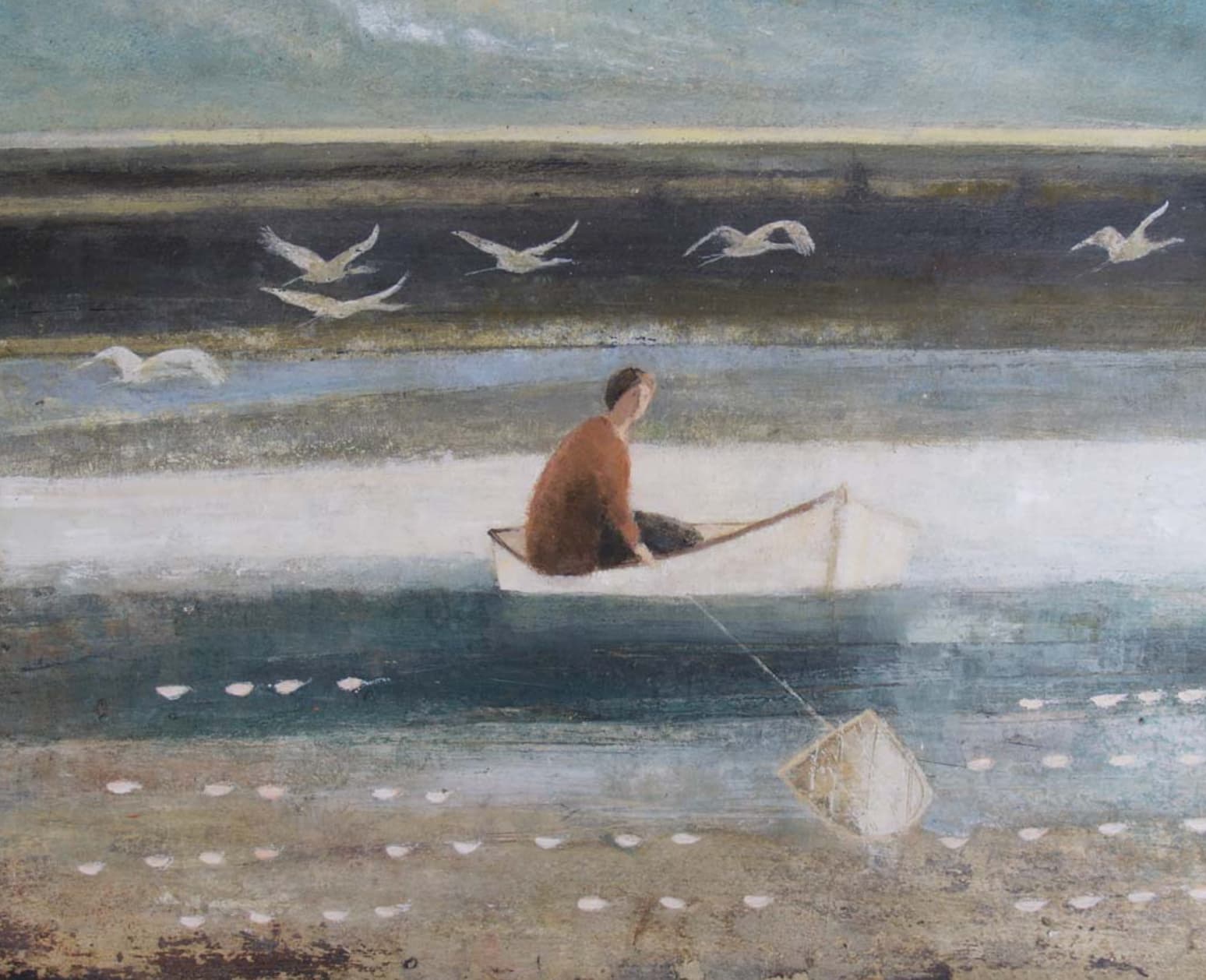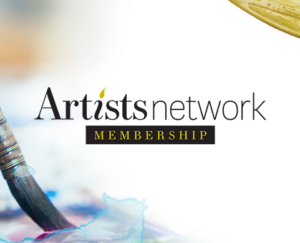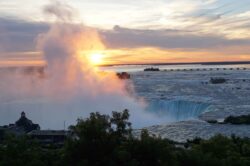Creating Imaginary Worlds in Watercolor

Learn how David Brayne’s imaginative paintings convey lyrical narratives entrusted to the viewer’s interpretation.
By Ken Gofton

David Brayne isn’t your average watermedia artist. For starters, he mixes almost all of his own paints from his collection of nearly 100 organic and inorganic raw pigments. In fact, he’s even excavated red ochre pigment on a caving expedition.
And, unlike most traditional watercolorists, Brayne creates visibly textured surfaces for his imaginative paintings. “Some people are surprised by the description of my work as watercolor,” Brayne says. As a member of Britain’s Royal Watercolour Society, he enthusiastically agrees with its inclusive definition that a watercolor is “a painting in a water-based medium on a paper-based support.” This definition includes traditional pure watercolor, as well as combinations of it with other media, and new media altogether.
Also intriguing is the fact that almost all of Brayne’s imaginative paintings are of figures in a landscape or interior. And yet, both the people and their surroundings are products of the artist’s fertile imagination.

Mixing Pigments
When Brayne first tried acrylics, the range of colors available was quite limited. His initial response was to experiment by mixing earth pigments such as raw umber and yellow ochre with store-bought tube paint. Even though art supply stores stock many more colors today, and he has two or three tubes of his favorites, Brayne still relies on his trusty pigment collection and mixes his own paints.
“I have no objection to commercial colors,” says Brayne. “I sometimes use conventional watercolors if they offer the best solution for the effects I want; however, I generally can only achieve the particular luminosity, vibrancy and lyrical quality that I want by using pigments.”
To achieve those sublime qualities, Brayne says he uses lots of water and builds up many thin layers of paint. He also mixes the paints with gum arabic or uses acrylic mediums as a binder. “One acrylic medium I often use is Lascaux water-resoluble medium, which makes the paint almost identical to traditional watercolor,” he says. “If I re-wet the paint, it will lift off. That’s a property I like to play with.”

Making Several Paintings at Once
Watercolor is, after all, “just pigment suspended in water with a binder that sticks it to the paper,” Brayne says. “My standard approach is to use very wet, diluted paint and to work on a completely flat surface,” he continues. “This means that the largest I can paint is limited by how far I can reach. Partly because the paint is so diluted, and partly because the paper isn’t very absorbent and enables the paint to sit on top, it can take a long time to dry. As a result, I’m usually working on several paintings at once.”
Because of his painting technique, Brayne’s surface has to take quite a battering. His go-to choice is a 300-lb. paper sold under the Royal Watercolour Society name, which he uses “not out of loyalty but because I like the way the paper behaves.”

A Technique for Texture
Varying the paint’s texture is important to Brayne — and to the overall impact he strives to make. “I may use the wrong end of a paint brush or an etching needle to scratch into dried paint,” he says. “I like the effects I can achieve by introducing gold leaf, or — even better — silver leaf.
“When I incorporate a resoluble medium into a wash, I let it dry almost completely,” the artist continues. “Then I might splash it with water from a brush, leave it for a minute or two. I then apply blotting paper on top. Lifting it off almost immediately can create a lovely mottled effect as in Swimmers and Fisherwomen. It’s a textured appearance instead of an applied texture.” Of course, this technique produces varied results. “I can’t really control it, so sometimes I’m delighted and sometimes I’m dejected,” Brayne says. “When I achieve a quality I want to keep, I usually apply a clear coat of acrylic to fix the area.”
Be Open to Experimentation
Brayne is open to experimentation — and the resultant marks — with two notable exceptions. “I like just about every type of mark that can be made with paint except runs and drips,” he says. “That may be another reason why I like a flat working surface; painting flat means that the paint dries in a particular manner. I find runs and drips too distracting. They’re not ‘quiet’ and, looking at them, you can imagine them forming.”

Working from Imagination
In addition to his various textured surfaces, Brayne’s imaginative paintings characteristically contain relatively few, yet primarily large, shapes.
“When I’m in the studio, thinking of new shapes and colors and compositions, it’s very different from drawing from life where there’s endless variety,” Brayne says. “The way I work requires that I invent shapes and composition. It has to be a conscious pursuit.
“I used to enjoy life drawing when I did it regularly, but I don’t want to work from life in my paintings,” he explains. “Similarly, I’m not a plein air artist. My paintings are all of invented scenes, in a sense telling a story, and that’s not necessarily an easy option. I need a very controlled environment, with all my bits and pieces at hand.”
The Initial Drawing
Brayne’s starting point for his highly textured paintings is “a scruffy drawing in 2B or 4B pencil, maybe even with some marks using a chunk of red ochre, and with a web of lines and lots of rubbing out,” he says. “The initial drawing is always more detailed than the finished painting.”
In fact, the detailed pencil drawing is very much part of his thought process. “I find those first marks the most exacting part of my method,” he says. “It’s almost as if I first have to destroy or mess up that clean, white surface before I can get going properly. Then I try to see what’s important in the initial expression of the idea, or what’s not working. I’ve found that I have to respond to what’s in front of me all the time. American artist Richard Diebenkorn said, ‘Use and respond to the initial fresh qualities, but then consider them expendable.’”

The Beauty of Water
While imagination may be at the heart of Brayne’s work, it doesn’t mean he isn’t influenced by his environment. At one time, he lived in Lincolnshire, a notoriously flat part of England that’s home to big skies and open fields. At that stage in his painting career, his work was very minimalistic — and all about expanse and emptiness.
His newer paintings are still about open spaces, but these days, his home is within 6 or 7 miles of the Somerset Levels, a coastal plains and wetland area where, over the centuries, the residents have learned to adapt to regular, sometimes severe, flooding. It’s hardly surprising, then, that water has become a regular theme in Brayne’s paintings, even if the depiction can be somewhat ambiguous. It’s not always clear whether one is looking at a river, a lake or the sea.
“For me, the beauty of water is that it creates an extra dimension in a painting,” Brayne says. “Elements of the picture can be above it, on it, or within it. People can see these things in very different ways. Boats are perfect for containing the figures — they act like ‘space cages,’ holding the figures together; the fishing rods or nets link them both physically and metaphorically to each other and to the water.
“I like the idea of placing an oar or fishing rod in the hands of a figure,” he continues, “because it immediately creates a gesture in quite a lyrical way, which in turn suggests movement and begins to form patterns and rhythms that will run throughout the work.”

Up for Interpretation
Brayne leaves it to viewers to determine what stories the paintings are telling, and in a sense, everyone might find a different narrative. The imaginative paintings have a feeling of timeless folk tales, or again, with the depiction of people fishing with nets, religious connotation. There’s confirmation of that in the fact that Brayne’s local church has commissioned him to create an altar piece.
Not all of his landscapes center around water, though. “The horizon dominates much of my landscape painting,” he says. “In Orchard I, for example, I wanted to try something new and experiment with a different composition. I abandoned the use of conventional perspective and divided the picture with thick black lines, which created a space reminiscent of a theatrical stage set.”
As for his domestic interiors inhabited by lone figures, such as Blue Table, Brayne says, “I prefer simple, empty spaces when I’m painting an indoor scene. It’s much more difficult to make an interior work and keep the whole surface alive if the space is filled with lots of things.”
Projecting Naïvety
Brayne’s paintings, which are less abstract than when he first began painting, manage to be both timeless and avowedly modern. There’s also an appealing innocence to them, which the artist acknowledges is something for which he strives. “It’s not the easiest challenge, trying to project naïvety when you’re not naïve.” Brayne’s winning combination of innocence and textured luminosity creates intimate worlds in which the viewer feels privileged to enter.
See Brayne at Work in His Studio
Ken Gofton is an arts writer in Kent, in England.
 Artists Network Membership - 1 Year
Artists Network Membership - 1 Year  Breakthrough Paint Along: Where Mixed Media Combine Together
Breakthrough Paint Along: Where Mixed Media Combine Together  Paint Along 127: Paint the Motion of the Sea
Paint Along 127: Paint the Motion of the Sea  Breakthrough Paint Along: The Big Value of Miniature Landscapes
Breakthrough Paint Along: The Big Value of Miniature Landscapes  Portrait Painting: Rembrandt's Techniques Video Download
Portrait Painting: Rembrandt's Techniques Video Download  Figure Drawing Tips with Brent Eviston Video Download
Figure Drawing Tips with Brent Eviston Video Download  Southwest Art August/September 2025 Digital Edition
Southwest Art August/September 2025 Digital Edition  Artists Magazine July/August 2025 Digital Edition
Artists Magazine July/August 2025 Digital Edition  Pastel Journal Summer 2025 Digital Edition
Pastel Journal Summer 2025 Digital Edition  Artists Magazine March/April 2025 Digital Edition
Artists Magazine March/April 2025 Digital Edition  Artists Magazine January/February 2025 Digital Edition
Artists Magazine January/February 2025 Digital Edition  Best of Watercolor: Winners of the Splash 26 Competition Print Edition
Best of Watercolor: Winners of the Splash 26 Competition Print Edition  Southwest Art June/July 2025 Print Edition
Southwest Art June/July 2025 Print Edition  Artists Magazine May/June 2025 Print Edition
Artists Magazine May/June 2025 Print Edition  Southwest Art 2021 Digital Collection × 1
Southwest Art 2021 Digital Collection × 1  Watercolor Artist 2020 Digital Collection × 1
Watercolor Artist 2020 Digital Collection × 1  Watercolor Artist 2019 Annual Digital Collection × 1
Watercolor Artist 2019 Annual Digital Collection × 1  Watercolor Mega Magazine Collection × 1
Watercolor Mega Magazine Collection × 1  Pastel for Beginners Workshop
Pastel for Beginners Workshop  Composition & Design for Landscape Painting Video Workbook
Composition & Design for Landscape Painting Video Workbook  Drawing Mastery: Shading Course
Drawing Mastery: Shading Course  Alla Prima Bootcamp: 4 Weeks to Confident Painting Course
Alla Prima Bootcamp: 4 Weeks to Confident Painting Course  Eight Greats: The Pastel Journal's 10th Anniversary Artist Interview Series Digital Download
Eight Greats: The Pastel Journal's 10th Anniversary Artist Interview Series Digital Download  Secrets of Hyperrealist Watercolor Course
Secrets of Hyperrealist Watercolor Course  Acrylic Artist Summer 2017 Digital Edition
Acrylic Artist Summer 2017 Digital Edition  Exploring Acrylic: Abstract Art in Action Video Download
Exploring Acrylic: Abstract Art in Action Video Download  WetCanvas Live! Paint Stunning Landscapes from Photos: Lesson 23 & 24 Video Download
WetCanvas Live! Paint Stunning Landscapes from Photos: Lesson 23 & 24 Video Download  WetCanvas Live! Paint Stunning Landscapes from Photos: Lesson 9 & 10 Video Download
WetCanvas Live! Paint Stunning Landscapes from Photos: Lesson 9 & 10 Video Download  The Whimsical Face with Jane Davenport Video Download
The Whimsical Face with Jane Davenport Video Download  Mixed-Media Faces Made Easy Video Download
Mixed-Media Faces Made Easy Video Download  What It Takes to Teach Video Download
What It Takes to Teach Video Download  On the hunt for found objects: How to Create New and Eclectic Molds Video Download
On the hunt for found objects: How to Create New and Eclectic Molds Video Download  Urban Sketching: Drawing People in Places Video Workbook
Urban Sketching: Drawing People in Places Video Workbook  Graffiti Grunge Art by Jodi Ohl Video Workbook
Graffiti Grunge Art by Jodi Ohl Video Workbook  Portraits: From Good to Great Video Download
Portraits: From Good to Great Video Download  Low-Tech Metal Apps: Wire, Foil, Mesh, & Screen Video Download
Low-Tech Metal Apps: Wire, Foil, Mesh, & Screen Video Download 




Have a technical question?
Contact UsJoin the Conversation!